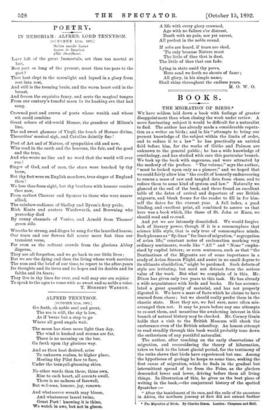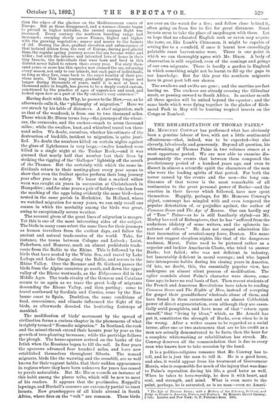BOOKS.
THE MIGRATION OF BIRDS.* WE have seldom laid down a book with feelings of greater disappointment than when closing the work under review. A more fascinating subject it would be difficult for a naturalist to find. The author has already made a considerable reputa- tion as a writer on birds ; and in his " attempts to bring our present knowledge of the subject within the limits of order, and to reduce it to a law" he has practically an untried field before him, for the works of Glitke and Palmen are unknown to the general public ; he has a wide knowledge of ornithology, and has studied with care this particular branch. We took up the book with eagerness, and were attracted by the modesty of the preface. " The volume," says the author, "must be looked upon only as a pioneer," and we hoped that we could fairly allow him " the credit of honestly endeavouring to rescue a mass of raw and tangled data from chaos, and to reduce them to some kind of system and law." Naturally we glanced at the end of the book, and there found an excellent table of the dates of arrival and departure of our British migrants, and blank forms for the reader to fill in for him- self the dates for the current year. A full index, a good binding, and excellent print, all combined to assure us that here was a book which, like those of St. John or Knox, we should read and re-read.
And yet we are intensely dissatisfied. We would forgive lack of literary power, though if it is a commonplace that science kills style, that is only true of commonplace minds. Such phrases as " fly-lines " for lines of migration, " segregation of avian life," constant notes of exclamation marking very ordinary sentiments, words like " All " and "None" empha- sised by capital letters ; or even sentences, such as that "the Destinations of the Migrants are of some importance in a study of Avian Season Flight, and assist in no small degree to its ultimate elucidation," might be pardoned. Such defects of style are irritating, but need not detract from the serious value of the work. But what we complain of is this. Mr_ Dixonhas given only two years to this task. He has already a wide acquaintance with birds and books. He has accumu- lated a great quantity of material, and has not properly digested it. We have a mass of facts which he claims to have rescued from chaos ; but we should really prefer them in the chaotic state. Here they are, we feel sure, more often mis- arranged than not. It may be years before any one attempts to re-sort them, and meantime the awakening interest in this branch of natural history may be checked. Mr. Corney Grain holds that a visit to the British Museum will check the exuberance even of the British schoolboy. An honest attempt to read steadily through this book would probably tone down the enthusiasm of any youthful naturalist.
The author, after touching on the early observations of
migration, and reconsidering the theory of hibernation, takes us back to the latest glacial period, for the testimony of the rocks shows that birds have experienced but one. Among the hypotheses of geology he keeps ns some time, seeking the first cause of migration, which he finds in the gradual but intermittent spread of ice from the Poles, as the glaciers descended lower and lower, driving before them all living things. In illustration of this, he gives us the best piece of writing in the book,—the conjectural history of the spotted flycatcher:— "After the banishment of its race, and the exile of its ancestors in Africa, the northern journey at first did not extend further * The Migration of Birds, By Charles Dixon. London: Chapman and Hall. than the edges of the glaciers on the Mediterranean coasts of Europe. But as these disappeared, and a warmer climate began to prevail in higher latitudes, the annual summer flight was increased. Every century the northern breeding range had increased; creeping slowly across France, higher and higher with the growing vegetation ; nearer and nearer to the haunts of old. During the slow, gradual elevation and submergence of that isolated Albion from the rest of Europe, during post-glacial time, the regular spring journey across the sea became wider and Wider ; but with the intense and inherited love of home in their tiny breasts, the individuals that were born and bred in this district never failed to return there every year. For sixty thou- sand years or more has this species now crossed the sea, returning every season, not only to our islands, but each pair of individuals, as long as they live, come back to the exact locality of their pre- vious nests. This long journey, gradually growing longer and longer during thousands of years, until it is now at least a thousand miles in length, has grown to be a deeply rooted custom, sanctioned by the practice of ages of experience and need, and looked upon now as a part of the fly catcher's very existence !"
Having dealt with the Why, he passes to the How,—or, as he afterwards calls it, the "philosophy of migration." Here we are struck by his table of distances. A short migration, such
as that of the woodcock, is from one to two thousand miles. Those which Mr. Dixon terms long—the journeys of the wheat- ear, the corncrake, and the cuckoo—reach to seven thousand miles ; while the swallow, knot, and whimbrel travel ten thou- sand miles. We doubt, ourselves, whether his estimate of the destruction of bird-life, incident to migration, is quite justi- fied. No doubt the numbers killed on certain nights against the glass of lighthouses is very large,—twelve hundred were killed in a single night at the Taskar Rock, and it was guessed that nearly half that number lost their lives by striking the rigging of the Galloper' lightship off the mouth of the Thames. But the certainty with which the same in- dividuals return to their nesting-place every year seems to show that even the frailest species perform their long journey year after year in safety. We know that a marked willow wren was caught six years in succession at Christchurch in Hampshire ; and for nine years a pair of hobbys—the hen from the marking of the eggs being evidently the same bird—have nested in the same parish in Berkshire. In Holland, where we watched migration for many years, we can only recall one season in which the mortality among the birds was great, owing to exceptionally severe weather.
The account given of the great lines of migration is meagre. Yet this is one of the most interesting sides of the subject. The birds in many cases select the same lines for their journeys as human travellers from the earliest days, and follow the ancient and natural trade-routes of the world. Take, for
instance, the towns between Cologne and Lubeck ; Loest, Paderborn, and Hanover, mark an almost prehistoric trade-
route from the Baltic to the Rhine. This is followed by the birds that have nested by the White Sea, and travel by Lake Ladoga and Lake Onega along the Baltic, and across to the Rhine Valley. Over the Brenner and St. Gothard passes the birds from the Alpine countries go south, and down the upper valley of the Rhone westwards, as the Eidgenossen did in the Middle Ages. The trade rivalry of the Genoese and Catalans occurs to us again as we trace the great body of migrants descending the Rhone Valley, and then parting ; some to travel southward by Sardinia and Corsica, some by the Nar- bonne coast to Spain. Doubtless, the same conditions of food, convenience, and climate influenced the flight of the birds, as afterwards directed the hesitating footsteps of mankind.
The modification of birds' movement by the spread of civilisation forms a curious chapter in the phenomena of what is rightly termed " Nomadic migration." In Scotland, the rook and the missel-thrash extend their haunts year by year as the growth of tree-planting increases; while the partridge follows the plough. The house-sparrow arrived on the banks of the Irtish when the Russians began to till the soil. In four years the sparrows advanced four hundrel miles, and have now established themselves throughout Siberia. The nomad migrants, birds like the waxwing and the crossbill, are so well known for their vagrant habits, that their sudden appearances in regions where they have been unknown for years has ceased to puzzle naturalists. But Mr. Dixon records an instance of this habit among the plover tribe, which will be new to most of his readers. It appears that the pratincoles, Ruppell's lapwings, and Birchell's coursers are extremely partial to roast locusts. Now grasshoppers of all kinds abound in South Africa, where fires on the "velt " are common. These birds are ever on the watch for a fire ; and follow close behind it,. often going on from fire to fire for great distances. Roast locusts seem to take the place of snapdragon with them. Let us hope that no educated English rook or raven may acquire the taste, or, like Lamb's Chinaman, it might be capable of setting fire to a cornfield, if once it learnt how exceedingly palatable roast harvest-mice were. There is one point in which we can thoroughly agree with Mr. Dixon. A body of observation is still required, even of the comings and goings of our own migrants. There is hardly a garden in England. in which something might not be learnt to fill up the gaps in our knowledge. But for this year the southern migrants have in great part left our shores.
The swallows and swifts are gone ; and the martins are fast leaving us. The cuckoos are already crossing the Gibraltar strait, or passing onward to South Africa. In another month all three species will be united beyond the equator ; and the same birds which were flying together in the glades of Rich- mond Park in May will be hunting tropical insects on the Congo or Zambezi.



































 Previous page
Previous page